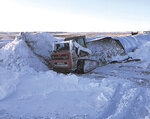


FLASHER, N.D. – A mid-April blizzard roared across the northern Great Plains, blasting the region with heavy snow driven by hurricane-force winds.
“It seemed as if Mother Nature was mad at us,” Bob Hintz said. “The wind was fierce. It was trying to tear all of our buildings apart.”
[[In-content Ad]]
Bob and his wife, Debbie, and their sons, Luke and Mark, milk 250 Holsteins on their dairy farm located near Flasher in southwestern North Dakota. The Hintz family has four robots that handle the bulk of the milking on their farm. The Hintzes continue to milk a small number of cows in their milking parlor.
Luke said that Monday, April 11 was a beautiful day, 55 degrees and sunny with no outward signs a blizzard was brewing. By the morning of April 12, the ferocious winter storm was ravaging the Hintzes’ dairy farm.
“I looked out the door on Tuesday morning at 6 a.m., and we had total whiteout conditions,” Bob said. “Travel was impossible. They closed (Interstate) 94 all the way from Billings, Montana, to Jamestown, North Dakota. The milk truck couldn’t make it to our farm for three days. Thankfully, we had enough milk storage to see us through. I think there may have been some dairies in the path of the storm that were forced to dump milk.”
Blinding snow and high winds would continue to harass the Hintz farm and a vast swath of the surrounding region for three straight days. Luke said the family did what they could to prepare for the blizzard, fueling up tractors and skid loaders, mounting and servicing the snowblower they hadn’t used since 2019.
“The weather went from sunshine to the North Pole in one day,” he said.
On Monday he gave the milking herd three days’ worth of feed.
“That was the best thing I did, because mixing feed in that wind would have been extremely challenging,” he said. “The milk cows had it good during the blizzard. They had plenty to eat and were inside where it was nice and cozy.”
The youngstock are housed 5 miles away on an additional farm site. Bob said there’s a highway bridge to cross to get to the other farm.
“Snowdrifts had filled the bridge up to the tops of the guardrails” he said. “The boys blew it out with the snowblower so they could get through and feed the cattle. When they returned 45 minutes later, the bridge was completely blocked again. You couldn’t even tell that they had been there.”
Luke said the blowing snow caused zero visibility.
“I couldn’t see anything beyond the tractor’s hood,” he said. “I had to use the tractor’s GPS system to find my way back home from the other farm because it was impossible to see where the road was. It was a nerve-wracking experience because I had to put all of my trust in what was on the GPS screen.”
He guessed they received two-feet of snow. A neighbors’ weather device that recorded a peak wind speed of 74 mph during the blizzard.”
Luke and his wife, Chelsea, were married last summer and live in a trailer home on the farm.
“My wife’s car, which was parked on the west side of our trailer, was totally buried under a snowbank,” Luke said.
The Hintz farm never lost electrical service throughout the blizzard. In 2012, in the wake of a devastating ice storm, the Hintzes went without electricity for 26 consecutive days. As luck would have it, they had purchased a standby generator that was large enough to power their dairy and their home.
Despite all of the problems the blizzard caused, the Hintz family is glad to receive the moisture even in the form of snow. Bob said because the frost is out of the ground the moisture should all soak into the soil if the snow melts slowly.
“But because of the high winds we had during the blizzard, there’s hardly any snow left out in the fields,” he said. “It seems like much of the snow ended up where we don’t want it, in our shelter belts and on our farmsteads. I would say that our snow depth ranges from nearly nothing to 20 feet.”
The Hintz family farms about 1,200 acres of corn, alfalfa, oat and barley. All of their crops are used as feed for their cattle. Luke said the blizzard was the biggest moisture event they’ve had in two years. The family’s silage corn went 3 to 6 tons per acre. The crop insurance adjustor said that the small grains yielded half a bushel to 2 bushels per acre, Luke said.
“We received only five inches of snow this past winter,” Luke said. “We were beginning to wonder if we should even plant anything in the dry dirt. The moisture from this snow is enough to at least give us some hope.”
Bob said despite the hardships of the storm, he is grateful their livestock lived through the blizzard.
“Our sons are only in their 20s, so they haven’t experienced a blizzard like this one,” he said. “We’ve had so many open winters over the past few years, so this is something new for them. I’m glad they got to see for themselves what it’s like to go through a major winter storm like those I’ve told them about. It’s April and the sun is at a high angle and the snow will soon melt. We hope that this blizzard is a sign that more moisture-producing weather events will be coming our way.”
Comments
No comments on this item Please log in to comment by clicking here